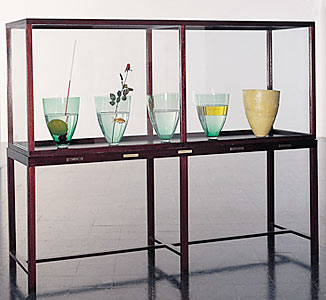
Born in 1955 in Zurich (CH)
Lives and works in Mettmann (DE)

1993
Installation
250 x 200 x 75 cm
Year of Purchase: 1994
‘Objects, the only ones still visible, are what remains of the broken unity of being and appearance. Pictures always refer to the loss of what they have set before our eyes.’1
Since his very first exhibition in 1982 at the Künstakademie of Düsseldorf, Thomas Huber develops a ‘total’ artwork which combines production, exhibition and discourse about the genesis of painting and art. Working in the unstable fault that separates perception from reality, he creates a direct similarity between the image subjected to the eye’s gaze, its didactic lectures about what is on view, and the props used during the demonstration thereof.
Thomas Huber proceeds by way of analogies and creates an ongoing reversal of the image, upon itself. So Das Wesen des Bilder (The Essence of Images) is the prop acting as a back-up for the public lecture whose subject is the history of the picture Die Ausstellung (Fnac/Fonds national d’art contemporain, Paris). Five recipients, placed in a display case, are the subjects of a ‘scientific’ explanation of the genesis of painting in which: water is the metaphor of imagery; a goldfish and a rose illustrate the look from within, the fragile surface, and the nothingness that delimits different perceptible realities and the notion of the illusionistic threshold in painting; the mixture of oil and water embodies the boundary; the salt symbolizes the density of pictures; the sponge is a reservoir, a memory; the thermometer helps to calculate the energy released from the substance; the soap describes the emulsifier which links eye and reality.
Depending on the appearance of the picture being talked about, viewers end up inside the image reflected endlessly in both image and discourse. At the intersection of such paths, Thomas Huber constructs a destabilizing gap between inner perception and outer reality, in the time and space of the ‘performance’, by toying with the vague boundary between differing sign systems.
In the tradition of the research embarked upon by Joseph Beuys on signs and language as the origin of human creative transmissibility, Huber’s art builds meaning by using the technique of formulation. From the material and immaterial space of words, picture and place, he extracts the chemical process whereby art’s reality is transformed. As heir to German Romanic thinking, his approach situates the artist at the hub of a complex metaphor, made up of endless shifts of meaning, which come from the symbolic, aesthetic, philosophical and social nature of the elements.
Maïté Vissault
1 Thomas Huber, ‘Discourse on creation’, in Art et Language, Rennes, 1988.